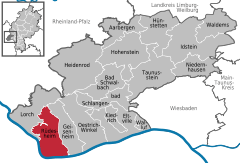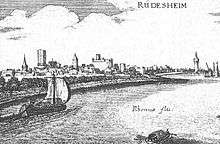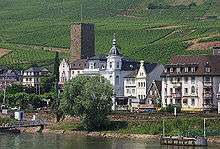Rüdesheim am Rhein
| Rüdesheim Rüdesheim am Rhein | ||
|---|---|---|
|
Rüdesheim seen from nearby vineyards | ||
| ||
 Rüdesheim | ||
Location of Rüdesheim within Rheingau-Taunus-Kreis district 
 | ||
| Coordinates: 49°59′0″N 07°55′50″E / 49.98333°N 7.93056°ECoordinates: 49°59′0″N 07°55′50″E / 49.98333°N 7.93056°E | ||
| Country | Germany | |
| State | Hesse | |
| Admin. region | Darmstadt | |
| District | Rheingau-Taunus-Kreis | |
| Government | ||
| • Mayor | Volker Mosler | |
| Area | ||
| • Total | 51 km2 (20 sq mi) | |
| Population (2015-12-31)[1] | ||
| • Total | 9,873 | |
| • Density | 190/km2 (500/sq mi) | |
| Time zone | CET/CEST (UTC+1/+2) | |
| Postal codes | 65385 | |
| Dialling codes | 06722 | |
| Vehicle registration | RÜD | |
| Website | www.ruedesheim.de | |
Rüdesheim am Rhein is a winemaking town in the Rhine Gorge and thereby part of the UNESCO World Heritage Site. It lies in the Rheingau-Taunus-Kreis district in the Regierungsbezirk of Darmstadt in Hesse, Germany. It is officially known as Rüdesheim am Rhein, which distinguishes it from Rüdesheim an der Nahe.
Geography
Location
Rüdesheim lies at the foot of the Niederwald on the Rhine's right (east) bank on the southern approach to the Lorelei. The town belongs to the Frankfurt Rhine Main Region and is one of Germany's biggest tourist attractions. Only Cologne Cathedral draws more tourists from other countries. Making the town worth visiting is, not only the wine or even the Old Town itself, but also the picturesque Rheingau landscape together with the romantic Rhine.
Territorial structure
Rüdesheim am Rhein as a municipality consists of five Stadtteile:
- Rüdesheim am Rhein (initial part and center)
- Eibingen including Windeck, St. Hildegard's Abbey and Nothgottes
- Assmannshausen
- Aulhausen including Marienhausen Abbey and St. Vincenzstift
- Presberg
Assmannshausen as well as Aulhausen as well as Presberg have the status as a Ortsbezirk.
Neighbouring communities
Rüdesheim borders in the east on the town of Geisenheim, in the south on the town of Bingen, in the west on the communities of Weiler and Trechtingshausen (all three in Mainz-Bingen district in Rhineland-Palatinate) over on the other side of the Rhine, and in the west and north on the town of Lorch.
History

The area was settled first by the Celts, then after the turn of the Christian Era by Ubii and later by Mattiaci. In the first century, the Romans pushed forth to the Taunus. In Bingen they built a castrum, and on the other side, near what is now Rüdesheim, lay a bridgehead on the way to the Limes.
The Romans were followed by the Alamanni, and along with the Migration Period (Völkerwanderung) came the Franks. Archaeological finds of glass from this time suggest that there was already winegrowing in Rüdesheim even then. The town's origin as a Frankish Haufendorf (roughly, "clump village") can still be seen on today's town maps.
Rüdesheim had its first documentary mention in 1074. Its livelihood came mainly from winegrowing and shipping, particularly timber rafting.
On 1 January 1818, Rüdesheim received town rights.
After Prussia annexed the Duchy of Nassau in 1867 and divided the area into districts (Kreise), Rüdesheim became a district seat in the newly founded Rheingaukreis. This status it held for 110 years until 1977, when in the course of municipal reform in Hesse the districts of the Rheingaukreis and the Untertaunuskreis were merged into the new Rheingau-Taunus-Kreis, and Rüdesheim had to yield the district seat to Bad Schwalbach. However, owing to its widespread recognizability, the old car licence designation RÜD came through the shift in district alignment unchanged, despite all the existing rules that would have seen SWA become the new district's designation.
In 1877, the first foundation stone for the Niederwalddenkmal, which would be finished in 1883, was laid. This patriotic monument drew a great many tourists, who at that time reached the site high above the town on a cog railway, although today it is a gondola lift that brings visitors up to the monument. Tourism is more and more displacing shipping as a source of income.
In 1939, under the secrecy that held sway at the time, the formerly self-governing community of Eibingen was forcibly amalgamated with the town by the National Socialists, against the community inhabitants' will. In 1977, within the framework of municipal reform, Assmannshausen, Aulhausen and Presberg also became new Ortsteile of Rüdesheim.

Politics
Town council
The municipal election held on 26 March 2006 yielded the following results:
| Parties and voter communities | % 2006 |
Seats 2006 |
% 2001 |
Seats 2001 | |
| CDU | Christian Democratic Union of Germany | 44.8 | 14 | 52.0 | 19 |
| SPD | Social Democratic Party of Germany | 23.4 | 7 | 32.3 | 12 |
| FDP | Free Democratic Party | 3.0 | 1 | 15.7 | 6 |
| WIR | Freie Wähler-WIR. Wählerinitiative Rüdesheim am Rhein | 23.6 | 7 | – | – |
| Offene Grüne Liste | Offene Grüne Liste Rüdesheim | 5.1 | 2 | – | – |
| Total | 100.0 | 31 | 100.0 | 37 | |
| Voter turnout in % | 46.4 | 49.7 | |||
Town partnerships
 Meursault, Côte-d'Or, France
Meursault, Côte-d'Or, France Juliénas, Rhône, France (twinned with outlying centre of Assmannshausen)
Juliénas, Rhône, France (twinned with outlying centre of Assmannshausen) Oingt, Rhône, France (twinned with outlying centre of Presberg)
Oingt, Rhône, France (twinned with outlying centre of Presberg) Mezőkövesd, Borsod-Abaúj-Zemplén County, Hungary
Mezőkövesd, Borsod-Abaúj-Zemplén County, Hungary Swanage, Dorset, England, UK[2][3]
Swanage, Dorset, England, UK[2][3]
Culture and sightseeing
Museums
- Siegfrieds Mechanisches Musikkabinett, the first German museum for data-storage musical instruments. On an exhibition area of over 400 m², the visitor is introduced in an amusing way to the history of self-playing music and its instruments. From the gentle musical clock to the orchestrion, which weighs tons, the visitor sees and hears a cross-section from four centuries. Curiosities: unique collection of self-playing strings, such as the Hupfeld Phonoliszt Violina with six strings, Hupfeld Violina Orchestra (only known original in the world), Poppers Violinovo, and so on.
- Mittelalterliches Foltermuseum (“Mediaeval Torture Museum"), with many instruments of torture
- Asbach Distillery
- Rheingauer Weinmuseum Brömserburg, tells the Rüdesheim area's 1,000-year winegrowing history in the oldest castle in the Rhine Gorge World Heritage Site.
Buildings
 Niederwalddenkmal with gondola lift
Niederwalddenkmal with gondola lift
 Castle Boosenburg
Castle Boosenburg Burghotel Rüdesheim
Burghotel Rüdesheim Brömserburg
Brömserburg
- Niederwalddenkmal from 1883
- Ostein family's Niederwald Landscape Park from the 18th century
- Drosselgasse (German: Drosselgasse): The Drosselgasse is a lane in the heart of Rudesheim's old town full of beautifully decorated restaurants. Live band entertainment, brass instruments and dance music play all day and all night during the summer in the many wine taverns and open-air garden taverns along the 144-metre-long narrow cobblestone pedestrian street. Built in the 15th century, the Drosselgasse was for boat owners to move items from the river to homes in the town. Since it is Rüdesheim's most famous attraction it is almost always crowded with tourists.
- Pfarrkirche St. Jakobus ("Saint James's Parish Church") from the 15th century
- Burg Ehrenfels (ruined castle)
- Brömserburg, the oldest castle in the Rhine Gorge World Heritage Site with wine museum. It was built in the 10th century on the site of a Roman fortification. From the 10th to the 13th century it was owned by the Archbishop of Mainz. The old fortress was converted into a residence in the 12th century. It then passed into the control of the Knights of Rüdesheim. A branch of these knights was the Brömser. It was retaken by Archbishop Werner II von Eppenstein in 1281. The castle withstood a number of attacks. In 1640, during the Thirty Years' War, the top of the tower was destroyed by French troops under the command of Henri II d'Orléans, duc de Longueville. The Archbishopric sold it in 1803 and it has had several owners since then. The town of Rüdesheim bought the castle in 1941. Today it is a wine museum. It has a collection of wine presses and other wine paraphernalia. It has walls that are more than two-metre-thick and a metre-thick vault tower. Originally, it was right on the bank of the Rhine, surrounded by water.
- Binger Mäuseturm from the 14th century near Bingen.
- Eibingen Abbey above the outlying centre of Eibingen
- Remains of the Hindenburgbrücke (bridge destroyed in the Second World War)
Hiking trails
The Rheinsteig from Wiesbaden by way of Lahnstein to Bonn leads through Rüdesheim's municipal area by both the monastery and the Niederwalddenkmal. Another trail is the Riesling-Route. It leads along the Rhine and through Rüdesheim's enchanting vineyards on the way to Wiesbaden.
Tradition
A well known old tradition is the Weinkönigin ("Wine Queen") with her princesses. Each year in the summertime, the Rüdesheim wine festival is held, whose highlights include the Wine Queen's and the princesses' coronation.
The Wine Queen and her princesses represent the town of Rüdesheim and its wine in other communities and other winegrowing areas.
In the deeds held by the Counts of Katzenelnbogen, vineyards are already found in the Rüdesheim area in 1399: auf dem Berge ("on the mountain"), bei dem Morgen Marschalls ("near Marshal's acre") and unterhalb Eibingen am Fluß ("beneath Eibingen at the river").[4]

Rüdesheim lies in the north-west corner of the German wine producing region Rheingau. Riesling grapes are the main type grown in this area, producing mainly high-quality white wines. One can taste the local wines, including the Rüdesheimer Riesling, in the many wine houses in Rüdesheim.
 Lithograph 1898
Lithograph 1898 Lithograph 1898
Lithograph 1898 Lithograph 1897
Lithograph 1897
Music
In 1970, a single was released under the title Rüdesheim liegt nicht an der Themse ("Rüdesheim Does Not Lie on the Thames"). The artist was British hit singer David Garrick, who had a great hit with this song.
Regular events
- Magic-Bike-Rüdesheim (as a rule on Corpus Christi weekend)
- Tal total yearly on the last Saturday in June. On this day, Bundesstraße 42 between Rüdesheim and Koblenz on the Rhine's right bank and Bundesstraße 9 on the left between Bingen and Koblenz are closed to motorized traffic and left free for cyclists and skaters.
- Rheingau Musik Festival, usually a concert in the Eibingen Abbey and/or in the church St. Jakobus[5]
- Rhein in Flammen (fireworks festival) on first Saturday in July
- World Heritage celebration at the Niederwalddenkmal (since 2003 usually in late July on a Friday and Saturday)
- Weinfest (wine festival third weekend in August)
- Gallustag (Saint Galls day), festival to honour the grape harvest, mediaeval market and event
- Tage des Federweißen (year's last wine festival) late October, early November
- Weihnachtsmarkt der Nationen ("Christmas Market of the Nations") 120 stalls, open daily from late November until Christmas
Education
- Hildegardisschule (Realschule and primary school spread between two buildings)
- Nikolausschule (Assmannshausen primary school)
- Grundschule Presberg (primary school)
Famous people
The town's noble family called itself "von Rüdesheim". Its foremost representative was Rudolf of Rüdesheim (1402–1482), papal legate and Prince-Bishop of Breslau. After studying at the University of Heidelberg, he went on to Rome and became friends with Pope Pius II. He was named Prince-Bishop of Breslau in 1468.
Sons and daughters of the town

- Jacob Fidelis Ackermann (1765–1815), physician
- Theodor Friedrich Ludwig Dilthey (6 February 1825 – 22 March 1892), entrepreneur: He took over his father’s wine wholesaling business, Dilthey-Sahl & Co. in Rüdesheim, in 1852 and undertook many business trips to England and Russia to further German wine and sekt exports. In 1867 he was cofounder and first president of the Wiesbaden chamber of commerce. He composed many poems in praise of wine.
- Georg Geiling (1 June 1863 – 1947), master cooper: Geiling studied after his apprenticeship as a cooper in Reims and Épernay and in 1890 founded the sekt cellar "Georges Geiling & Cie." in Reims. In 1894, he settled in Bacharach, where in 1919 he built up his own sparkling wine factory.
- Antonius Wallenstein (20 January 1890 – 28 December 1964 on the Abtsberg near Gengenbach in Baden), Catholic priest of a religious order, spiritual writer. Works (selection): Das Problem der Willensfreiheit unter besonderer Hervorkehrung der methodischen Gesichtspunkte, in: PhJ 36 (1923), 1–24 (excerpts from his dissertation); Katechismus der christlichen Vollkommenheit, Freiburg 1930 (2nd ed. 1936); Kindheit und Jugend als Erziehungsaufgabe, Freiburg 1951; Klarheit über Gott, Leutesdorf 1959.
- Hermann Asbach (18 March 1894 – unknown), entrepreneur: one of Hugo Asbach’s three sons and later owner of the firm Asbach (Asbach Uralt, brandy).
- Rudolf Krämer-Badoni (1913–1989), writer and publicist.
- Hans Otto Jung (1920–2009) and his wife Ursula Jung, sponsors of musical institutions such as a chamber music series and "Brahmstage" in Rüdesheim, "Die Kammermusik" in Wiesbaden (he was president of the association since 1976),[6] Dr. Hoch's Konservatorium and the Hochschule für Musik und Darstellende Kunst Frankfurt am Main, founding members of the Rheingau Musik Festival.
- Karl Heinz Hock (born 1930), publicist and journalist.
- Marianne Vater (born 1952), professor of zoology at the University of Potsdam. Publications (selection): Frequenzanalyse und Frequenzrepräsentation im peripheren Hörsystem von Fledermäusen; Echolocation in Bats & Dolphins.
- Johannes Schild (born 1965), composer and conductor as well as professor at the College for Music in Cologne.
- Jennifer Braun (born 1991), pop/rock singer, runner-up of Unser Star für Oslo 2010.
- Note: The poet Stefan George (1868–1933) was not – as is often claimed – born in Rüdesheim, but rather in Büdesheim near Bingen, which is, of course, only a stone's throw away from Rüdesheim on the other side of the Rhine.
Other people linked with the town
- The composer Johannes Brahms (1833–1897) was repeatedly a guest at the family Beckerath's house in Rüdesheim (Oberstraße/Schmidstraße, today Sekthaus Solter) between 1874 and 1895. In 1883 in Wiesbaden he wrote the Symphony No. 3 in F major, Op. 90. At this time he also took part in the festive unveiling of the Niederwalddenkmal in Rüdesheim. In his witty letter of 1887 to Rudolf von Beckerath he let it be known that he enjoyed "things like your cellar and your fiddle, the wife's pouring and the husband's getting in the mood". In the rooms of the former Villa Sturm on Rheinstraße, the yearly Rüdesheimer Brahms-Tage (days) take place in the composer's memory.
- Bernhard Hopffer (7 August 1840 in Berlin – 20 August 1877 at the Niederwald hunting palace near Rüdesheim), an almost forgotten composer, he studied music at the Kullak'sches Conservatorium and lived as a composer in Berlin. His last years he lived, owing to his lung illness, in various spas. He wrote symphonies, chamber music, songs – among others, Lockung, Op. 22/1 (1872) after Joseph von Eichendorff – as well as an opera, Frithjof, which was first produced in Berlin in 1871.
- The celebrated German violinist Gerhard Taschner (1922–1976) lived from 1946 to 1950 in the house of the art-minded winemaker Carl Jung in Rüdesheim. In the piano trio with Ludwig Hoelscher and the legendary pianist Walter Gieseking, he gave a series of private concerts here.
- In the movie G.I. Blues (1960, German title Café Europa), Elvis Presley sang the duet Pocketful of Rainbows while sitting in the gondola over the vineyards of Rüdesheim. Presley himself never set foot in Rüdesheim; the background images were edited in later.
- German star actor Heinz Rühmann appears in the 1931 comedy The Merry Heirs that takes place in Rüdesheim and Assmannshausen.
Literature
- Ursula Jung 100 Jahre Villa Sturm zu Rüdesheim am Rhein Ein Beitrag zur Musiktradition im Rheingau (1991), DNB
See also
- Rheinsteig
- Rüdesheimer Kaffee, a local drink made with coffee and brandy
- Torture Museums
References
- ↑ "Bevölkerung der hessischen Gemeinden". Hessisches Statistisches Landesamt (in German). August 2016.
- ↑ Swanage Twinning Association website
- ↑ "Dorset Twinning Association List". The Dorset Twinning Association. Archived from the original on 21 June 2012. Retrieved 2013-08-01.
- ↑ graf-von-katzenelnbogen.de Stand: 14. Dezember 2007.
- ↑ St. Jakobus on the Rheingau Musik Festival website (German/English)
- ↑ Aus der Geschichte des Vereines (From the History of the Association), Wolf-Eberhard von Lewinski and Ursula Jung, 1992, a review of 120 years, presidency Dr. Jung p. 7
External links
| Wikimedia Commons has media related to Rüdesheim. |
| Wikivoyage has a travel guide for Rüdesheim. |
- Rüdesheim am Rhein at DMOZ (German)
- Town’s official webpage (German)
- Rüdesheim am Rhein website (German) (English)
- Brömserburg Wine Museum (German)
- Gondala website
- The History of the Oldest Riesling of the World
Documents
- Bild 1 von Rüdesheim aus J.F. Dielmann, A. Fay, J. Becker (Zeichner): F.C. Vogels Panorama des Rheins, Bilder des rechten und linken Rheinufers, Lithographische Anstalt F.C. Vogel, Frankfurt 1833
- Bild 2 von Rüdesheim aus J.F. Dielmann, A. Fay, J. Becker (Zeichner): F.C. Vogels Panorama des Rheins, Bilder des rechten und linken Rheinufers, Lithographische Anstalt F.C. Vogel, Frankfurt 1833

